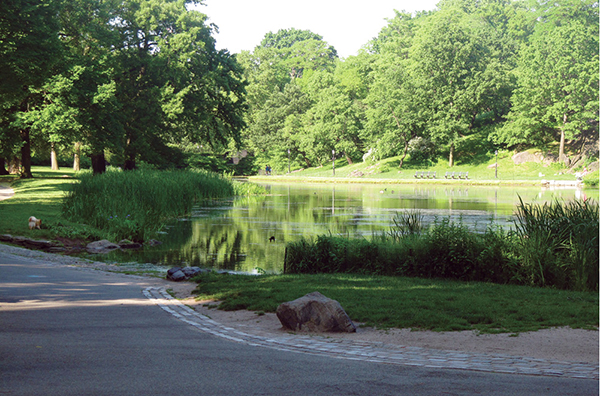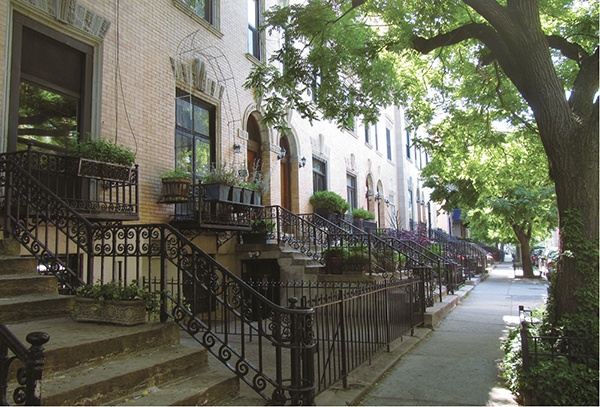5
Harlem Heritage Tour
Founded in the seventeenth century by Dutch farmers, Harlem became a nexus of cultural awakening during the Harlem Renaissance in the 1920s. From the Apollo Theater and Sugar Hill, to Striver’s Row and the Abyssinian Baptist Church, this ride takes you past innumerable spots that hark back to Harlem’s cultural heyday and continue to define the neighborhood today.
Start: The Farmer’s Gate to Central Park, at Central Park North and Lenox Avenue/Malcolm X Boulevard
Length: 11.1-mile loop
Approximate riding time: 1.5 hours
Best bike: Road, hybrid, or mountain bike
Terrain and trail surface: The trail is paved throughout and mostly flat. You’ll scale one short, steep hill from Saint Nicholas Avenue to Convent Avenue along West 141st Street. It then goes gently downhill along Edgecombe Avenue.
Traffic and hazards: This route leads along Harlem roads with light to moderate traffic. Only a few of the roads have bike lanes, so considerable city cycling comfort is required. Sunday morning traffic is lighter.
Things to see: Harlem Meer, Studio Museum in Harlem, Apollo Theater, Sugar Hill, Striver’s Row, Abyssinian Baptist Church, Schomburg Center for Research in Black Culture, National Jazz Museum in Harlem
Map: New York City Bike Map
Getting there: By public transportation: Take the 2 or the 3 subway to the Central Park North (110th Street) station. Go south 1 block on Lenox Avenue to reach Central Park’s Farmer’s Gate. GPS coordinates: N40 47.887’ / W73 57.147’
THE RIDE
The first portion of this journey hugs the edge of Central Park’s northeast corner, offering views of the park’s Harlem Meer, a man-made body of water whose name stems from the Dutch word for “lake.” Going northeast from here, you’ll soon reach Marcus Garvey Park, a Harlem mainstay for more than 150 years. Originally called Mount Morris Park, the site became a city park in 1840 and was later named after Marcus Mosiah Garvey, a Jamaican-born advocate of black nationalism and economic independence for African Americans. He moved to Harlem in 1916. To explore the park, dismount your bike and climb to the top of the hill, where you have a bird’s-eye view of the rest of your journey. (Alternately, return to the park at the end of the route to do so.)
Heading west along 125th Street, Harlem’s main drag and also called Martin Luther King Jr. Boulevard, you’ll pass numerous noteworthy neighborhood institutions. The road often has heavy car and bus traffic, so stay alert. Pass the Studio Museum in Harlem on your left, a promoter of artists of African descent since opening in 1968. Continuing west, the Apollo Theater sits on your right. When it opened as the Hurtig and Seamon’s New Burlesque Theater in 1914, African Americans were prohibited from entering both as performers and patrons. After a short period of disuse in the 1930s, the theater reopened in 1934, toward the end of the Harlem Renaissance, and soon became associated largely with black performers and culture.
Up ahead you’ll head north on Saint Nicholas Avenue, hugging the foot of steeply sloping Saint Nicholas Park. At the top of the hill you can spot the neo-Gothic spires of City College, founded in 1841 to provide free higher education to all. West 141st Street takes you steeply uphill to Convent Avenue. Along the way on your left sits a historical relic from an earlier era, the Harlem home of founding father Alexander Hamilton. Convent Avenue then hugs the edge of Sugar Hill, now part of the Hamilton Heights historic district. Covering approximately 10 blocks from West 145th Street to West 155th Street, and extending east to Edgecombe Avenue, it was dubbed Sugar Hill to evoke what was seen as the sweet life of Harlem beginning in the 1920s. Today, Convent Avenue is a quiet, residential street with elegant town houses.

The Harlem Meer, in the northeast corner of Central Park.
A short stretch along Saint Nicholas Avenue brings you to the short, cobblestoned Jumel Terrace, where another vestige of an earlier era sits on your left—the Morris-Jumel Mansion. Built and owned by a British colonel in 1765, it was George Washington’s headquarters during the Revolutionary War. Sylvan Terrace, on your right, was the mansion’s carriage path and today looks much the same as it did then, with two-story wooden houses on either side.
Edgecombe Avenue then takes you back into Sugar Hill along the edge of an outcropping overlooking Jackie Robinson Park and with sweeping views toward Long Island. Edgecombe Avenue was the favored street of many successful African-American musicians, actors, and professionals in the 1940s. Number 555 attracted musical giants including Count Basie, Duke Ellington, and Roy Orbison. Farther south, at number 409, residents included the writer and nationalist W.E.B. Dubois, US Supreme Court Justice Thurgood Marshall, and civil rights activist Roy Wilkins.
A little farther south, along West 138th Street you’ll hit upon Strivers Row after crossing Frederick Douglass Boulevard. The homes on this block were largely white-owned until the 1920s, when upwardly mobile black professionals—known as “strivers”—began purchasing homes here. Just beyond, east of Adam Clayton Powell Jr. Boulevard, the Abyssinian Baptist Church sits on your right. It was founded in 1808 by Ethiopian seamen and free Africans in America who wouldn’t accept segregated seating in their church at the time.
Heading toward East Harlem along Lexington Avenue, the National Museum of Jazz sits on your right, celebrating innumerable jazz greats who called Harlem home—Duke Ellington, Charlie Parker, and Count Basie, among them. The last stretch of journey then skirts the edge of Spanish Harlem along 2nd Avenue, with idiosyncratic community gardens sprinkled throughout the neighborhood. Pleasant Avenue then leads you north past the site that used to house the city’s first integrated public high school, Benjamin Franklin High School. (The spot now houses the Manhattan Center for Science and Mathematics.) One Hundred Eighteenth Street then takes you past Marcus Garvey Park once more (a block north of you) and through Central Harlem’s 1-block historic district before you return to your starting point.

MILES AND DIRECTIONS
0.0Bike east along Central Park North.
0.2Veer right into the roundabout and turn right onto 5th Avenue.
0.3Turn left onto East 108th Street.
0.4Turn left onto Madison Avenue.
1.3Turn left onto 125th Street.
2.0Turn right onto Saint Nicholas Avenue.
2.5Veer left to stay on Saint Nicholas Avenue.
2.8Turn left onto West 141st Street.
3.0Turn right onto Convent Avenue.
3.4Turn right onto West 150th Street.
3.5Turn left onto Saint Nicholas Avenue.
4.1Turn right onto West 162nd Street, followed by a right onto Jumel Terrace.
4.2Turn left onto West 160th Street, followed by a right onto Edgecombe Avenue.
4.5Diagonally cross Saint Nicholas Avenue, continuing on Edgecombe Avenue.
5.4Turn left onto West 138th Street.
5.9Turn right onto Lenox Avenue/Malcolm X Boulevard. The Schomburg Center is just ahead on your right.
6.0Turn left onto West 135th Street.
6.2Turn right onto 5th Avenue.
6.5Turn left onto East 128th Street.
6.8Turn right onto Lexington Avenue.
6.9The National Jazz Museum in Harlem is on your right halfway down the block on East 126th Street.
7.0Turn left onto East 125th Street.
7.2Turn right onto the bikeway along the east side of 2nd Avenue.
8.1Turn left onto East 108th Street.
8.2Turn left onto 1st Avenue.
8.5Turn right onto East 114th Street.
8.6Turn left to stay on East 114th Street. Continue straight onto Pleasant Avenue.
9.0Turn left onto East 119th Street.
10.5Turn left onto Frederick Douglass Boulevard.
10.7Go counterclockwise around the traffic roundabout. Exit to your right onto Central Park North, hugging the north edge of Central Park.
11.1Arrive at your starting point.
RIDE INFORMATION
Local Events/Attractions
Abyssinian Baptist Church: An important social, political, and religious institution in the neighborhood since 1808. 174 W. 136th St.; www.abyssinian.org
Alexander Hamilton Grange Memorial: Founding father Alexander Hamilton’s Harlem home. 414 W. 141st St.; www.nps.gov/hagr
Apollo Theater: Harlem’s famous performance venue. 253 W. 125th St.; (212) 531-5300; www.apollotheater.org
Morris-Jumel Mansion: Now a historic house museum, the mansion’s exhibits shed light on developments from the colonial era to today. 65 Jumel Ter.; (212) 923-8008; www.morrisjumel.org
National Jazz Museum in Harlem: A jazz museum in a spot where many former jazz greats resided. 104 E. 126th St.; (212) 348-8300; www.jazzmuseuminharlem.org
Schomburg Center for Research in Black Culture: A public library research branch dedicated to research into African-American life. 515 Malcolm X Blvd.; (212) 491-2200; www.nypl.org/locations/schomburg
Studio Museum in Harlem: A museum dedicated to the works of artists of African descent. 144 W. 125th St.; (212) 864-4500; www.studiomuseum.org
Restrooms
Start/end: There are restrooms in the Charles A. Dana Discovery Center along the shore of the Harlem Meer at the northeast corner of Central Park.

Strivers Row, along West 138th Street, named after the upward strivers who moved here in 1920s.